Webcast: What motivates teams across generations? Global study reveals significant changes
What really drives workplace motivation? Marlee's groundbreaking research spanning close to 400,000 professionals from 160 countries, reveals dramatic shifts in how different generations connect, engage, and thrive at work. Discover evidence-based insights to transform how your team collaborates and performs.
- Author
Marlee

The future of work hinges on understanding what drives it
For years, the conversation around generations at work has been clouded by assumptions, stereotypes, and headlines designed to spark division rather than understanding. But what if we had real data—insights grounded in the motivations and attitudes of today’s workforce—to cut through the noise?
In this exclusive webcast for HR.com, Michelle Duval, Founder and CEO of Marlee, unveils the key findings from Gen Z at Work: A Generational Impact Study—a groundbreaking global research initiative that has gathered attitudinal and motivational data from Baby Boomers, Gen X, Millennials, and Gen Z across 160 countries, including the US.
The study’s findings are game-changing, revealing critical shifts in what employees value most—connection, collaboration, development, leadership, and well-being. These aren’t just preferences; they’re priorities that will define workforce success in the coming years.
For HR professionals and business leaders, these insights present both an urgent challenge and a significant opportunity. From workforce planning to employee engagement, productivity to leadership development, understanding what drives today’s workforce isn’t optional—it’s essential for building sustainable, high-performing teams in 2025 and beyond.
Join us as we unpack these findings and explore the strategies HR leaders need to adapt, evolve, and thrive in the ever-changing world of work.
Watch the webcast
Read the webcast transcript
Hello, everybody. I'm Michelle Duval. I'm the lead researcher and also the founder and the CEO at Marlee.
Marlee is an organizational intelligence AI technology that helps to bring out the best in an organization and also its team. And I'm here today with one of my team members and also my co-researcher, Jack Rowlands. So Jack is going to say hi, and he is also going to be manning, so to speak, our chat today for this webcast.
So we're very excited to be sharing with you probably the most groundbreaking research that we've done to date here at Marlee.
We've got a meaningful research team, and the way that we do our research is to use proprietary data that we've collected globally. And for this particular study, we've been looking at the data of the attitudes and the motivations between two different global sample sets that we have.
So this particular research study has close to 400,000 participants in it and close to 90,000 from the US. And the data that you're about to be walked through today and these findings comes by comparing the sample that we have of the youngest generation, but every generation that we look at, compared to the executive workforce in the US. So that gives you a little bit of grounding and context in terms of what the research sample is.
And the sample for the global study that we did came from 160 different countries. And as you can see, the breakdown of the different regions in the world where we were able to collect the data from to share these findings with you. What we're going to look at today is generational.
And we're about to pop a little poll for you now that will help you to kind of tell us about you and which generation you are. So you'll see that we're going to mention the silent generation all the way down to Gen Z. And as you think about that, we're keen to know who's with us today, what kind of generational breakdown we have here. You can see the year that you were born or you can just choose the age that you were at the end of last year.
And that will give us the insight of who we have with us, which is looking extremely interesting. We're going to cut the poll off in a few seconds and then we're going to be able to share those poll findings with you now. So we've got the youngest cohort who is with us today is Gen Z. And our largest cohort here today is Gen X. So that's fun.
As we go through this, you start to think about how this applies to yourself and really importantly, to the younger generations that you're supporting in the roles that you have. So as we jump into the research, you'll be able to see the breakdown of the sample. And you can see in the US, it's a very normal kind of sample group that we look at in research today.
And the first area we're going to look at that has the biggest impact for our HR professionals is how connection and engagement at work is dramatically changing.
And when we look in here, we're going to take you through some of these key findings. And we're going to be looking specifically at the attitudes and motivations that drive connection and engagement in the context of work.
So over here, we're going to be asking the question, “How much abstraction do you need at work to feel engaged with the information? What causes you to disconnect?” And the two key data points that we're looking at here are at what we call Breadth and what we also call Depth.
Now, breadth is that big picture. So people who enjoy the big picture are comfortable with ambiguity, the bullet points, you're able to move rapidly between ideas because you don't need a lot of concrete detail to grasp it. You get it rapidly because it's abstract, and you like abstraction. And then when we look at depth in the data, depth means concrete, specifics, details, being able to have what, when, and how, and wanting information to be more concrete.
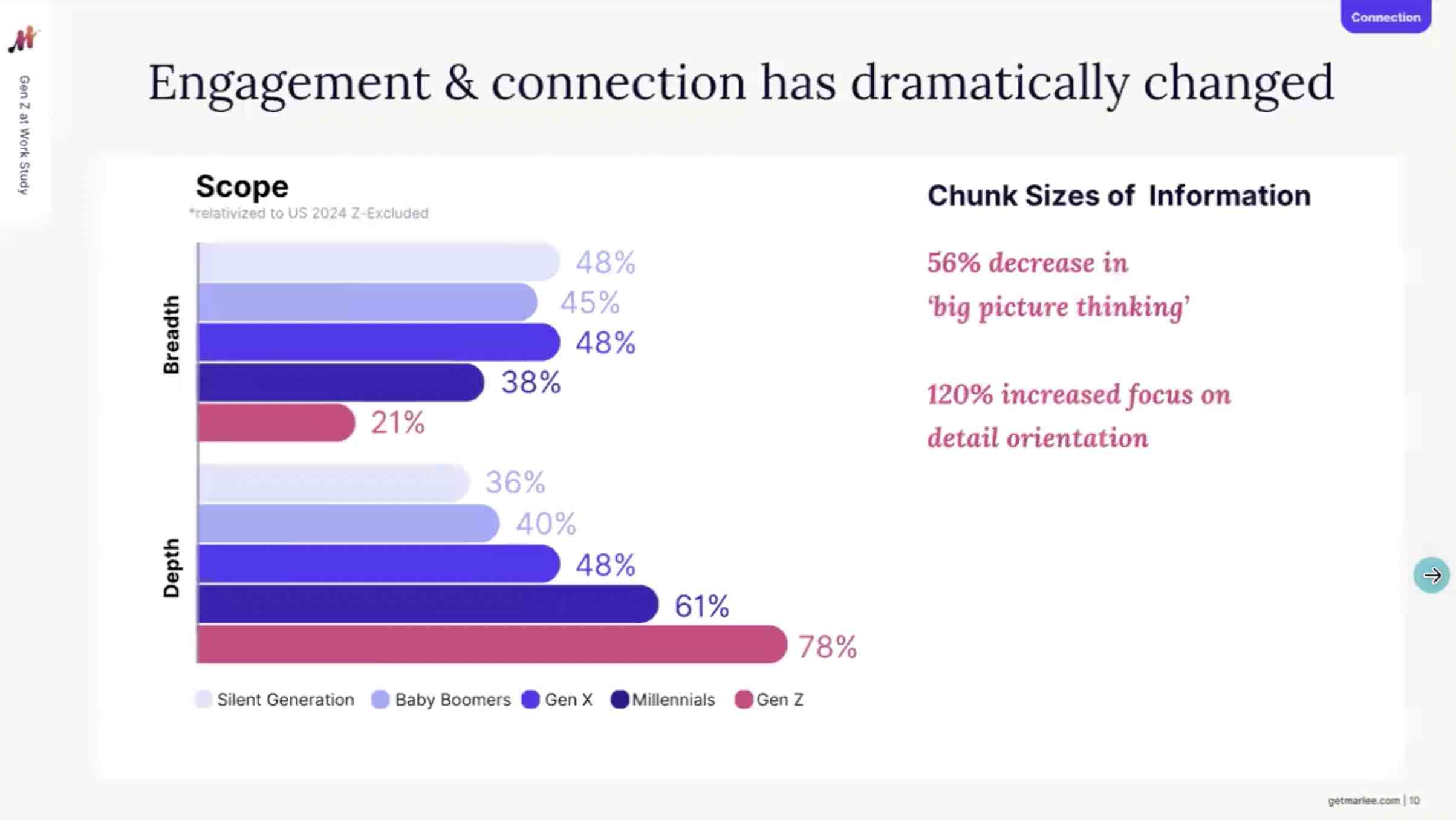
So when we look at the research findings, we can see through the generations. You can see the different colors here in the data, and you can use the key down the bottom to see and we can see the older generations at the top and the younger generations at the bottom, with the most recent generation at work being Gen Z. And you can see here that there is a significant decrease in the comfort and the desire to engage with abstract information.
We can see here a significant increase in what we call Depth orientation, you can see in here dramatic. It's actually increased across the generations by 120%. So what this means in the context of work is that our younger generations have increased anxiety and discomfort when things are shared with them in ambiguous ways. For what you as a Gen Xer, given the majority of you on here are Gen Xers, we can see in here that you have more comfort and are naturally inclined to speak more abstractly. And for the younger generations in the workforce, this is unclear.
It is confusing. And there is much greater discomfort to engage and connect with what's being shared. And so what we see a lot more of coming through in the younger generations is that if things stay the way they are today in the systems and way we communicate, we're seeing a greater level of overwhelm, getting lost in all of the detail.
Because what we know is that in order to be able to understand priorities, we need to be able to have a bigger picture to know what's important. And if our younger generations are not engaging or seeking out or recalling the bigger picture, we can see, and we're starting to track in our data and also in the teams and the organizations that we work with around collaboration and engagement, that they're having much more difficulty connecting with each other in that context.
So when it comes to what actions that you can take in your roles as you start to facilitate the organizational changes that are needed to bridge the gaps, is that we need to reduce the ambiguity. We need to connect with our younger generations with more concrete, specific language and always providing the details that are needed.
👉 Bridge generational gaps at work—compare your motivations with Gen Z and other generations with Marlee. Activate insights now.
And as you're about to see, the way that the younger generations engaged in what channels of communication has also dramatically changed.
And so here what we're looking at is “What channels, what ways does the younger generation gain confidence, and what's the fastest route to provide an engagement and connection in the context of work?” Now, what we're seeing in here is, and looking at Seeing.
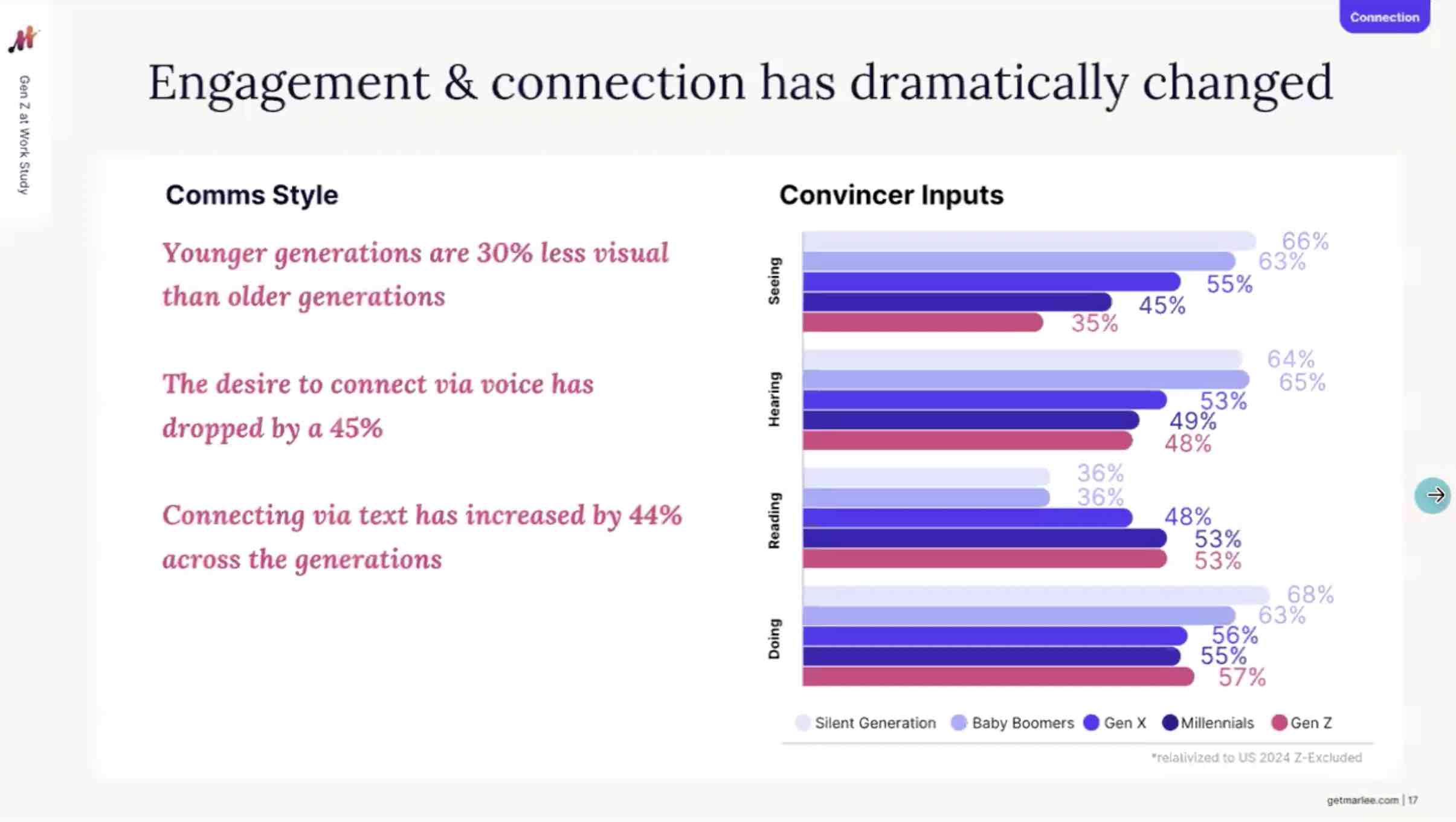
So seeing is about communicating in person, using visuals like this presentation. Seeing is about written sometimes tools. Hearing is about verbal communication, which might be through audio recordings, in-person communication, voice notes, listening, learning from podcasts, and learning where there is auditory input.
Reading is around either reading text or using text, which could be written form in a document or across messaging channels like Microsoft Teams or Slack. And then the final one is what we call Doing, which is the need for experimenting, getting hands-on, and trialing something in order to be able to engage and to be connecting. And then what the data shows here is, that our younger generations are dramatically less visual.
They rely less on the visual inputs. They don't need it in the same way that the older generations do. And we're also seeing that the younger generations' desire to connect and need to talk something through or the comfort to talk something through has dramatically dropped as well.
And finally, we're seeing that the most dominant preference is to connect and to engage via written text. So you can imagine this has significant implications in how messaging moves through an organization and how when it's crucial to engage and to connect with a team member, how we have flexibility over the medium and are aware of our own biases.
So when you think about yourself, are you more visual? Do you need to talk things through? And how much is that impacting the way that you actually engage? So what we're seeing here is that the younger generations need things in the written form in order to learn and in order to be convinced and to hear something as an instruction and to be able to make decisions and, really importantly, for them to feel confident.
We've all seen those memes on Instagram or TikTok where we've seen the younger generations extremely nervous to make a phone call. I'm sure you've seen those. What we know from that is it's actually not just a funny meme. Our data indicates the very same thing, that anxiety of having to talk about something, it might be easier for the younger generations to deal with difficult things initially via text, chat, written form as we start to think about engagement through that lens.
The next one here looks at people's energy at work and how we unlock engagement and motivation at work.
And when we talk about motivation, you'll see we're talking about intrinsic motivation.
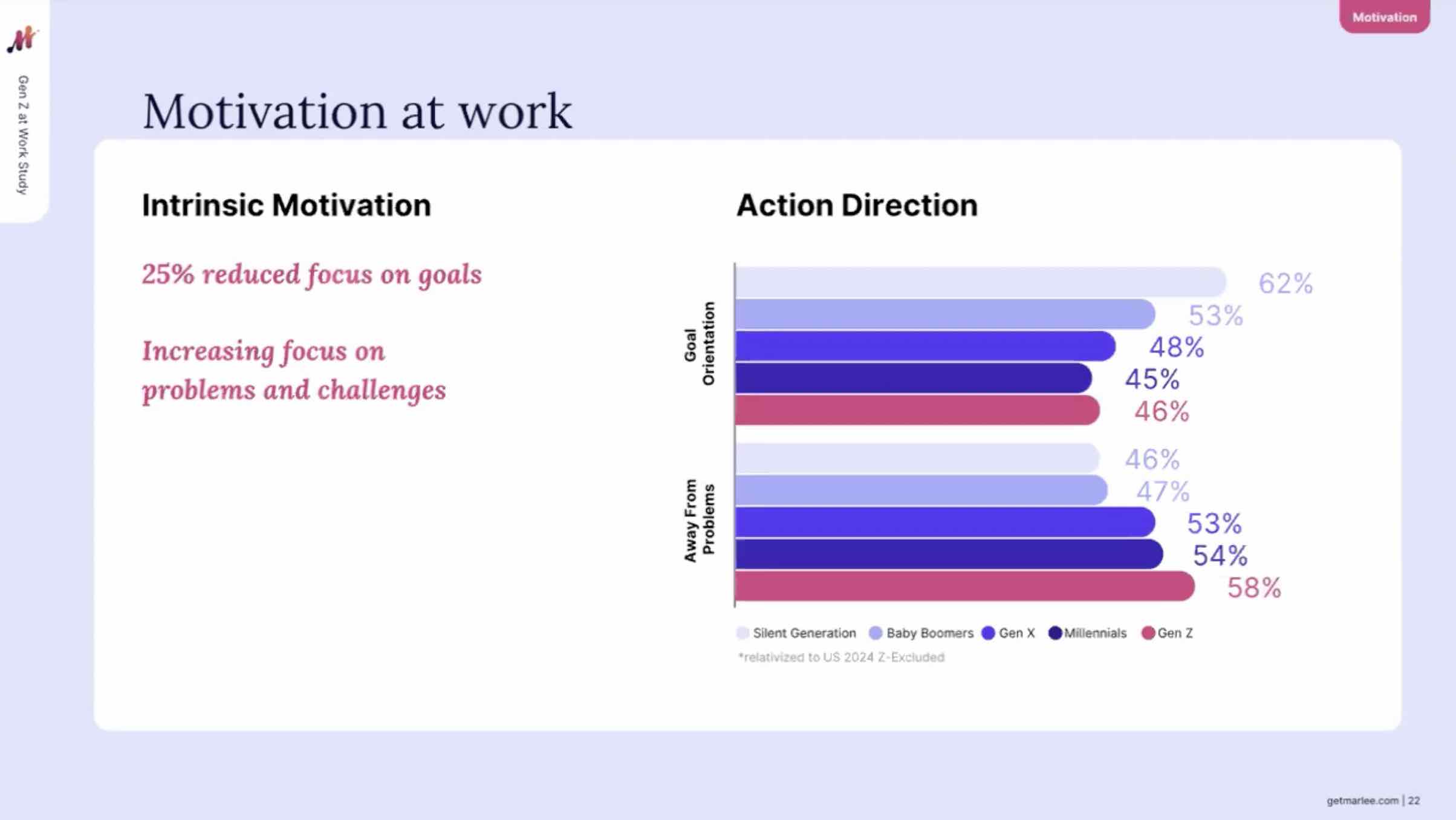
And this is answering the question, “What gets me excited about my work? What causes me to thrive in my work?” And the two dimensions that we're looking at here are what we call Goal Orientation. That means having a vision, being aware of goals, working towards targets, and being able to see milestones. And as we can see in the older generations, as you'll see in a moment, it's very much what the workplace has been built around, which is goal orientation.
And then, Away from Problems means seeking out, looking for and wanting to find what are the problems and the issues that we need to solve and move away from. So this is a bias of looking for issues, looking for problems. And the person who's motivated by this gets energy from challenges, gets energy from looking at the risks of things.
So in your roles, we'll often see in HR professionals, a really strong bias towards Away from Problems because it's very much a core part of your role, which is to forward think about the risks. So let's see how that looks now, here is that we're seeing a 25% reduction, so we're trending towards for Millennials and Gen Z, less motivated, less inspired by goals.
And we can see that there's a change here around an increasing focus on problems and an increasing focus on challenges. In some of the qualitative data that came out, the younger generations told us that they are nervous about the future, generally with what's happening on the planet, and they are very focused in wanting to solve those problems. And they have less trust in lofty visionary kind of goals.
And what this means in an organizational context is that leaders and organizational comms that only focuses on the lofty, ambitious goals can feel out of step if we're not also talking about the reality of the state of play in the team or in the company or in the macro economic environment and the genuine issues that are facing people at work.
And so the older generations are going to have a bias towards wanting to, you know, just talk about where we're headed. But the younger generations want to deal with reality a lot more. And so what this means is we need to support them and to motivate them, definitely still need to have goals. Vision and goals still are important. But if we fail to acknowledge the issues at hand, there's going to be a lack of engagement, and it's not going to be as motivating as it could be if people feel like we're dealing with reality.
This next one looks at what we call Action Level and what we also call the level of proactivity.
“Are you have low proactivity, or are you high on proactivity?” And this is a real question about, you know, do you prefer to rapidly act on your ideas or do you want to pause? Do you want to wait before you take action?
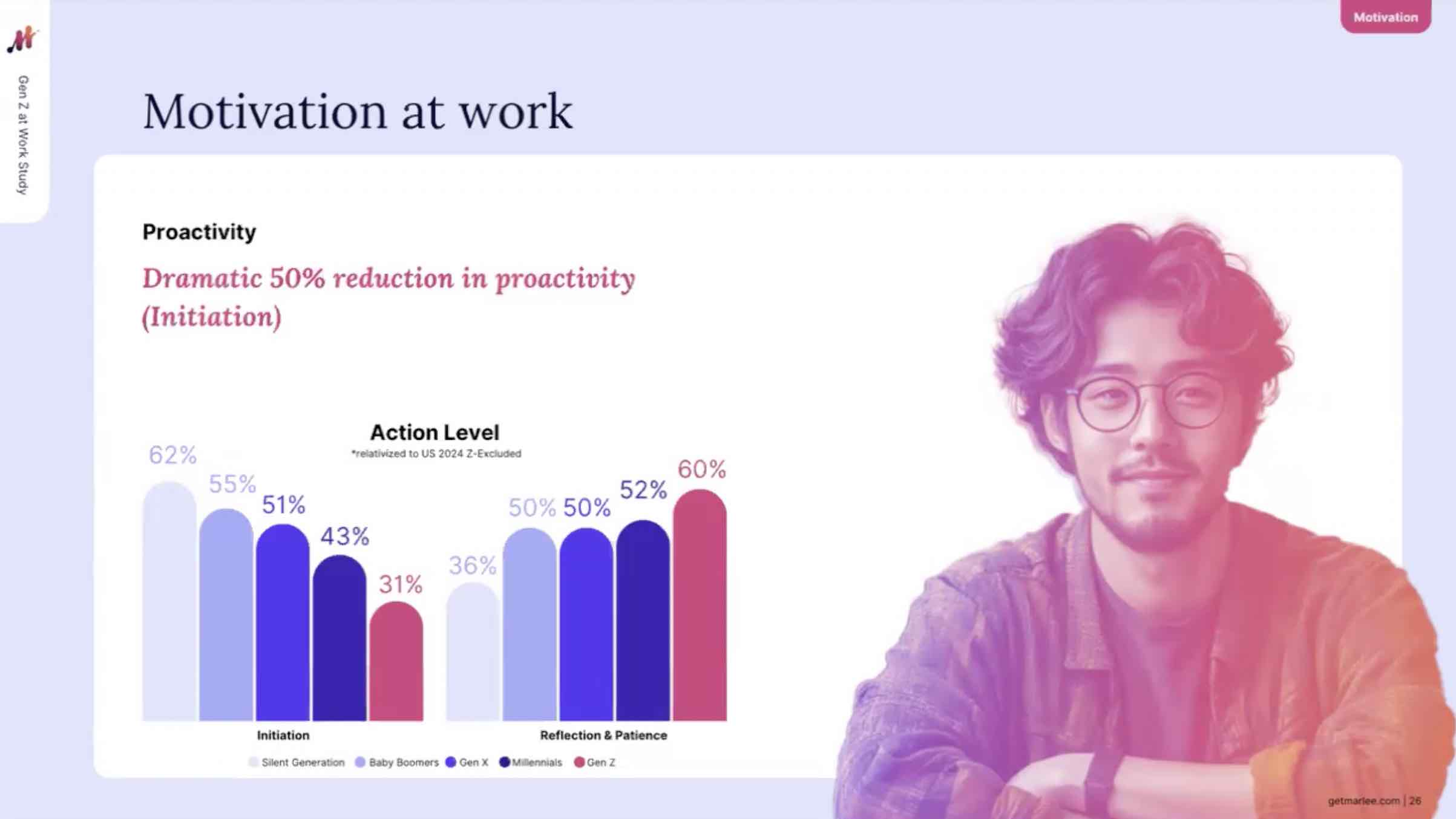
Now, in our data of HR professionals, we see a trend very strongly towards Reflection and Patience. And in some of our senior leaders, we see a trend towards Initiation. But when we look at overall the generational data that we're seeing, we can see here a dramatic reduction.
Look at that in what we call Initiation. Now, Initiation is the speed at which you start something, which could be making a phone call, organizing a meeting, kicking off a project, raising a difficult topic, or moving something along. And the distinction about Initiation, it actually is taking a step without necessarily knowing what the next steps are, not necessarily having a solid plan.
Now, when we look at leadership in general, we'll see initiation is a key trait and a key driver of effective leadership in any size organization. And so, as you'll start to see, this is a very concerning trait and trend that we can see that our younger generations are not comfortable to take a first step unless they know all the following steps.
And when it comes to the preference to pause and reflect, we can see this has dramatically increased. So we often hear the younger generations talk about procrastination. We also see this in the data that we've collected. We focus a lot on diversity and we also focus a lot on neurodiversity. And this is one of the traits we see heavily also in our neurodiverse data and populations. And this is a desire to wait for somebody else to initiate. And so what we see here is procrastination.
We see discomfort, and this is a word we use called self-efficacy, discomfort to trust oneself to figure things out as we go. So we see a greater level of words being used like “I fear I could fail,” “I don't know the next step,” and “I've never done this before, so I can't take the first step.” And so this is having a rapid change on the way younger generations onboard and how they move through work. And so what we see here initially, to be able to get momentum, that other people need to initially, do the initiating.
So rather than putting them and dropping them into a role where other generations would figure it out, drop them in the deep end, let them figure it out; for this generation, that will cause them to have anxiety.
Now, I'm sure all of you are across the bigger data. There are some wonderful researchers in the world, and we now know who published this in 2024. We now know that we have the largest level, highest levels of anxiety ever recorded at work. And so as we're starting to look at the environments, which you as the professionals that you are across the organizations, we know the highest levels of burnout, lowest levels of productivity, and the highest levels of anxiety. So this is an area in here that this data starts to really deeply reflect that.
And so instead of dropping the younger generations in the deep end and then figuring it out as they would have in the past, it actually causes a freeze state, a paralysis state, a procrastinating state, and a loss of confidence. So what we need to do is tell them this is the product, initiate and give them a deadline to meet. And that's going to help build confidence and clarity about what's required of them. Now, as you see, as we get further through to the strategies, there are strategies to overcome this, but this is about building confidence rapidly.
Now, this one looks at “What are people most interested in doing in their work, and how is this changing?” So this is like what functions or what types of tasks at work excite me and motivate me.
Now, the biggest changes that you'll see in here is 100% increase in a desire to work with time. So if you look here at this data, you'll be able to see down here, this is the older generations. And look at this dramatic change here.
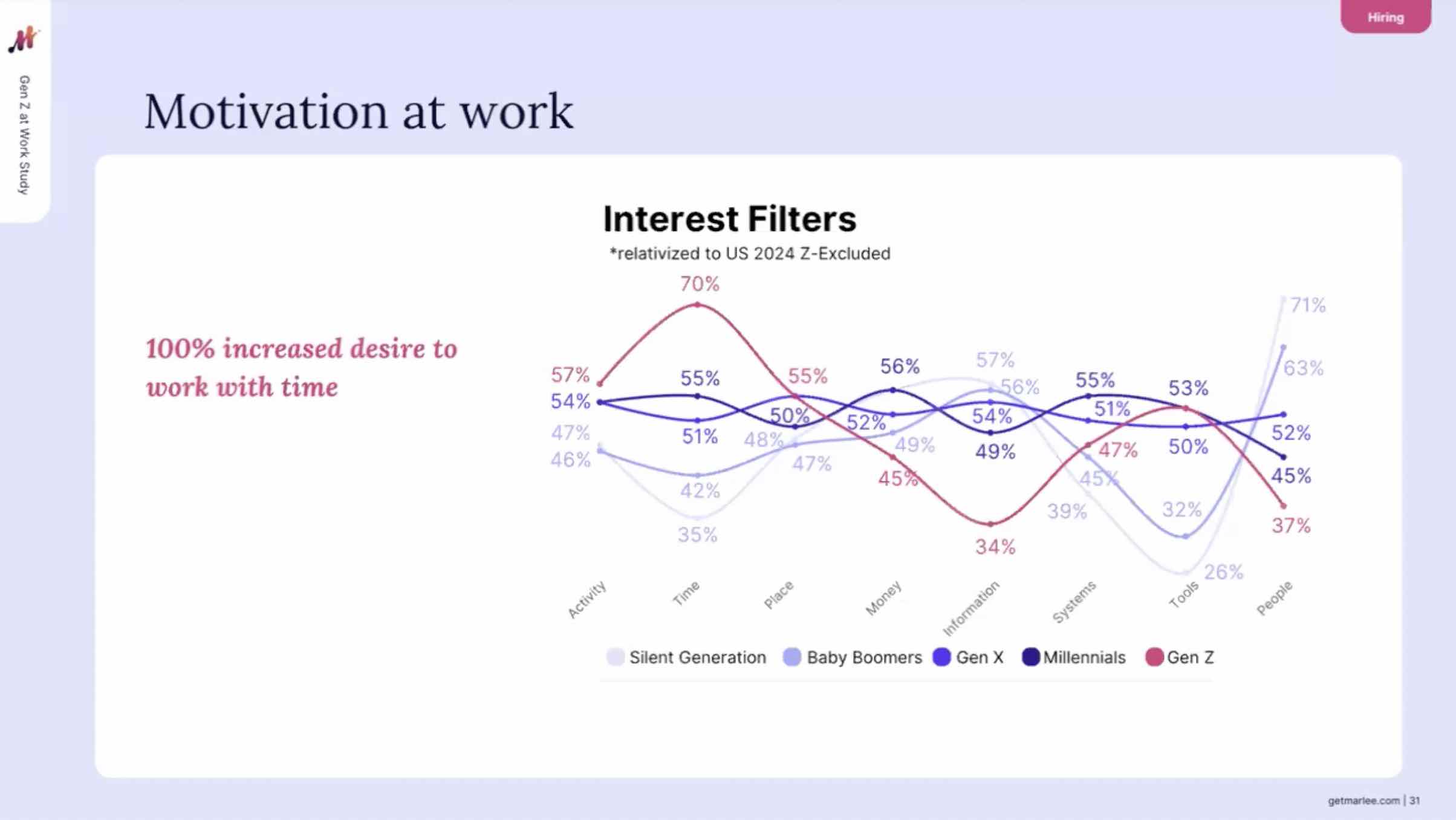
What it means to work with Time means working with schedules, things that require chunks and intervals of time. So roles and tasks and functions that are aware of time, using time, consciously working towards time. It also means that this generation, and it seems counterintuitive to some of the things that we see, but that this generation, it's important to be on time, to start on time, to know what the deadline is.
And that's why understanding this and using deadlines can become really helpful in helping the younger generations to know what the target is in terms of time. The next one that we're looking at here is an increased focus on Tools and technology. So this is this one over here. And you can see down here, unsurprisingly, I guess, the older generations, a very low focus. It wasn't important what tools they're using, what processes they're using at work, what technology. But what we can see here is that the younger generations, the tools, the tech, the software that they're using, the processes, is super important.
And so they're most motivated about working with the latest tools, the latest technologies, the latest innovations. And so being in roles where they're engaging with the tools and the technology is super important to them. And so when we look at talent acquisition and we look at employer branding and attracting the generations that we want, this gives us insight into what will attract and retain those team members.
What's really curious in here is that Money is a declining focus. Other data and other research is showing that as Jack and I looked through all the literature of what's been published in the last few years, we're seeing in all the data that money is less important. So money, in terms of remuneration is less important.
So if we look up here, we can see that Gen Xers, those of us, I'm a Gen Xer, and many of you said you were too, we care about the money at work. So we're looking at budgets. We're looking at working with, you know, the commercial side of business, is important to us.
But what we're seeing here is, and in the declining part here on the generations is that for our younger generation, specifically the Gen Z group, is that they have less of a preference and a priority on what they're being paid. They'll choose other things above and beyond that, and they're not as focused on the commercial side of business.
And then finally, one of the most significant changes is here around People. So in our data, a focus on people means working with and looking at people, you know, working directly in a role that's humanistic. So for me, my earliest background is being a professional coach. So I'm a person who likes working directly with people.
You've got other, you know, leadership roles. I'm assuming those of you as HR professionals, you enjoy working directly with people and the human stuff. Look at the change here. So our older generations, it's the primary thing that they are focused on at work. We can see Gen Xs and Millennials. It's important.
Millennials, more important than, you know, Gen X and Millennials, but look how low it is for our younger generations. And so we can see that trend. We can understand why with them being totally digitally native. So you can imagine the implications of that on the future of work.
The next one looks through the lens of how do people work together, what are the biases and what's the data showing us around teamwork and collaboration and how the work gets done when there's groups of people working together.
And so this answers the question, “How do I prefer to approach a project?” As you well know, it's one of the hardest things in project management, in collaboration and teaming, is “Where do we start in the project? What part of the project should I be working on and how do we move the project forward?”
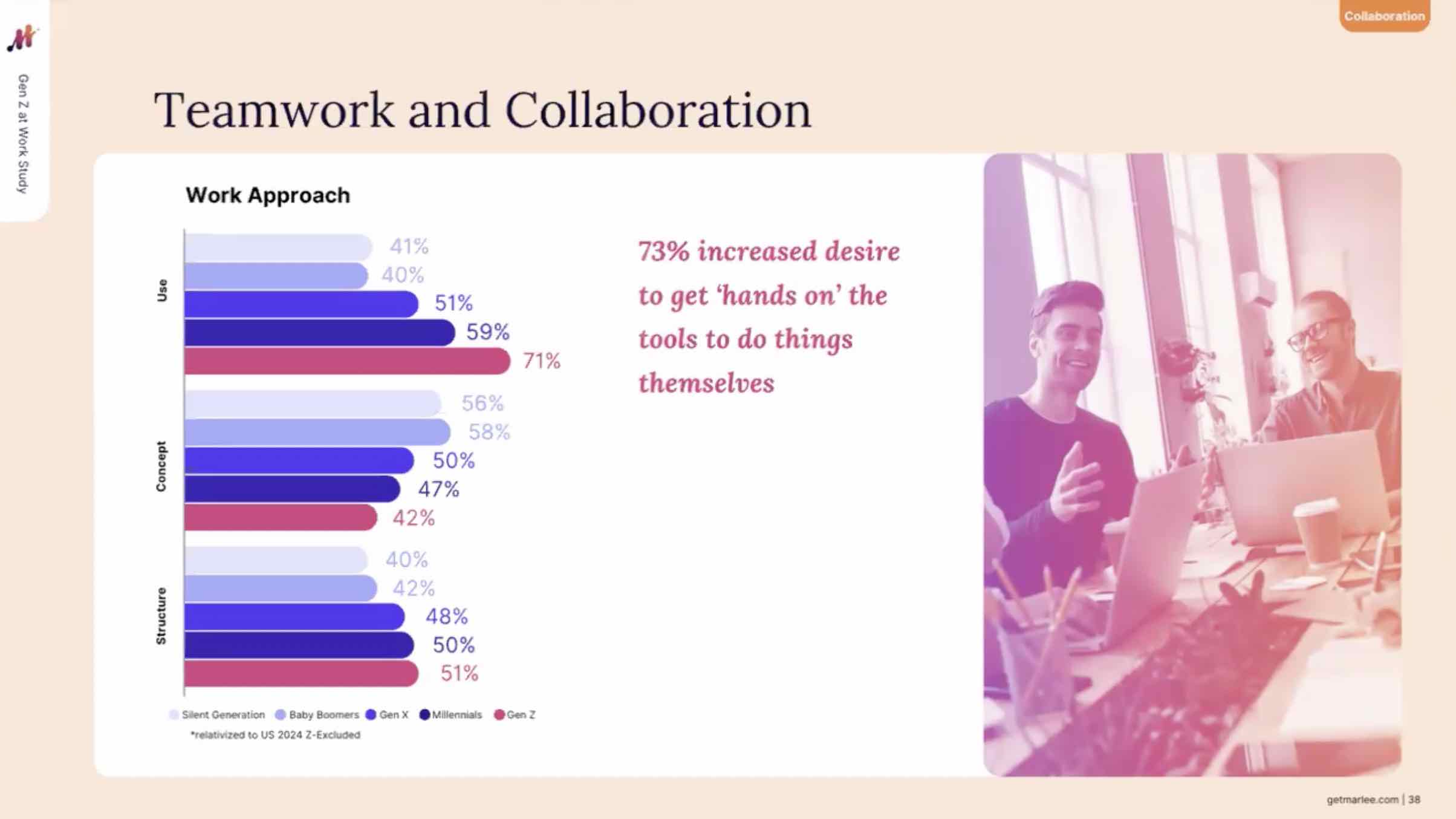
And the dimensions that we're measuring here, is something that we call Use. Someone who's got a high motivation for use means that they are most energised to engage with the project in the actual tasks of doing the project. They want to get their hands in. They're emergent.
Let's figure out the project by starting the project and just doing what needs to be done as we do it. So it's highly experimental. So people who like Use are often in start-ups, high-growth ventures, innovative roles, or roles that are very experimental and creative. People who like the concept are very Simon Sinek-orientated. They want to know the why. “Why are we doing this project? What's the thesis of this project? What's the mental model for this project, and how do I, you know, why are we doing it?”
Someone who's motivated for Concept does not want to start the project until they know, well, “Why are we doing it? What's the objective?” And then, finally, we've got our structurists and those of you who like Structure, you don't want to waste any time in your mind unless we've planned the resources, and know what our resources are. We have a map and a model for how we're going to work through the project. Now, as you're listening to this, you'll identify yourself, of course, and different people have different biases and gravitate to different roles that require that.
But as you can start to see in the data, there are some significant emergent changes that are occurring. So we can see in here that:
There is a significant increase in getting hands-on, not wanting to plan, wanting to jump right on in. So this is kind of impulsive, right? This is, “Let me just at it, let me just have a go at it.” And so what this means is people who are high on use, they can learn rapidly. They apply their learnings rapidly. The best way for them to learn is by doing rather than the theoretical models behind it.
So as you're thinking for those of you who are in learning and development, and you can see how this is emerging now, that this experiential learning is the fastest route to learning that we can see. So take note. This is going to be crucial and become even more crucial as you think about the teams that you're engaging with and you're thinking about the strategies that you're rolling out. In the past, our learning models are much more theoretical and we have much more planning. So it's still needed.
You can see there's not much change here around Structure. Concepts dropped, so the mental model is less, but this is the significant one where it's changed. So they'll thrive by being able to get experientially into the doing of the project.
👉 Compare your work motivations with Gen Z and other generations. Start for free with Marlee and gain instant, personalized insights.
Okay, this one looks at the nuance between when we're working in teams, should we all be following a methodology?
Should we be working through things step by step, which is what we call procedures? In other parts of life we call this a recipe. Or should we be figuring things out as we go? Am I comfortable to figure things out as I go? Which is inventing, which is bespoke, which is highly flexible and highly adaptive. In the data that we collected this from in Marlee, this is called Alternatives thinking.
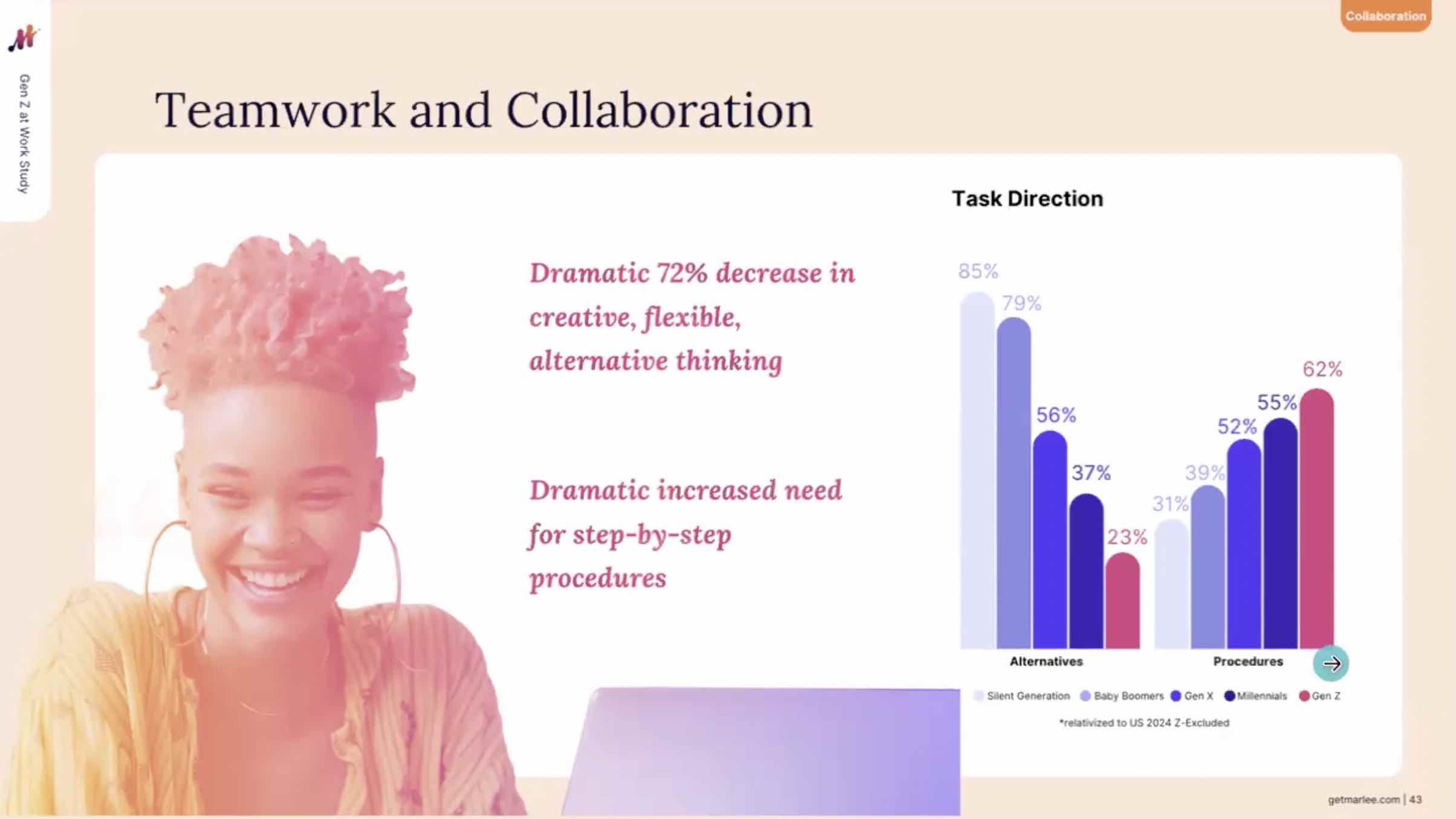
So we'll see this is highly creative. So when we see in the data, we see significant, significant changes here. So we can see that there's a dramatic drop in comfort and the flexibility to think in alternatives.
So what this means is that our younger generations are less confident, and in many cases, not confident at all, unless they have the step-by-step Procedure. They need to know what's the step and the sequence and what is the order of things to do. And without this, of knowing the sequence, they can experience significant increased anxiety in a cohort that already is prone to anxiety. These are the things that increase the anxiety.
So the nuance here is that this generation needs to go and find what's the best practice, where's the YouTube for it, give me a demonstration, tell me what the steps are, and they can be confident to complete the task. But if they're asked or dropped or parachuted into something, again, as we've already seen from the earlier data, it is very hard to be able to figure it out, they’re not flexible.
So we'll see a lot more rigidity in this group. They're like, “But best practice says,” or “You told me to do it this way,” or “This is how it's done and this other company that I've worked at.” And so they won't be as flexible or as adaptable to be able to seek that change.
So as you can imagine, as we're looking at change management initiatives or performance management initiatives, being able to map out the method, the steps in the process, can help everybody move towards the change and be adaptable but using a process to achieve the adaptation.
Okay, so in a team, who makes the decisions and how we make the decisions is a crucial part of collaboration.
And so this looks at “Who or where should we author the decisions?” So in the data, Internal Reference, what this means is that I have my own criteria, I trust my own values and own criteria, and I can trust my own point of view. External Reference is saying that I like to look externally at the data, customer feedback, employee data, and feedback and sentiment. And I go to the data or the expert or the mentor or I prefer my manager to make decisions. It's not for me to author the decisions. So internal is, I can author the decisions. External is other data, also is the source of truth for decision-making.
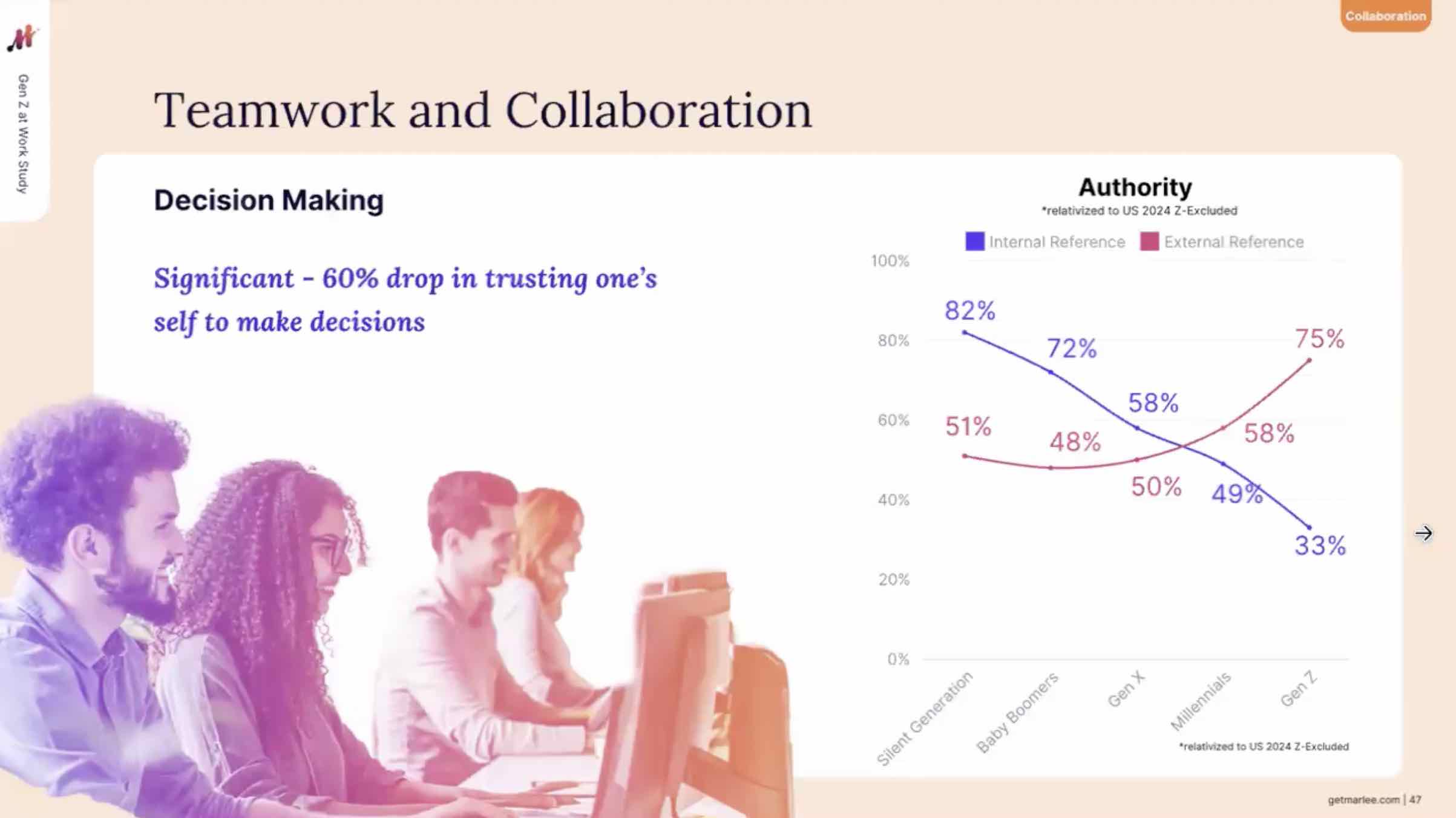
And as you'll see, significant changes. We'll look at this here. Now, often people, since we've been sharing this data, this data, by the way, only came out at the very, very end of last year. And in the cohorts where we've shared the report, there's a comprehensive report on this that we're making available to you as well. This is one of the most alarming findings. Now, people often say to me, well, this is age-related, but we actually have data from over 20 years, and we can see that this data is not age-correlated.
👉 Download the Gen Z at Work Study
So this is really concerning and it makes a lot of sense when we know how much our younger generations have been required to externally reference in social media and living a much more external life than the older generations. And as we can see here, this bigger increase, of looking to external sources. So what this means is that someone who has a low trust in their own point of view, if they're asked to have to author their decision and to communicate their point of view, surprisingly, because it's surprising, that can be very anxiety-inducing.
And so that's where anonymity in surveys, when we want to really feel out what the sentiment is in a team, these things can be used to help understand what the team is feeling and to help to know what is happening in that kind of a process. So that becomes super important in that process. And it also means providing them with a sounding board, providing them with an environment where they have someone they can bounce their ideas off, they can sense check, that they can get data, that they can have a mentor, they can have an advisor, or they can have a buddy that they're working with on a day-to-day basis.
We see extremely decreased engagement for an individual whose younger generation, who's in a role where they don't have any peers that they communicate with, where they're in an individual contributor role. So this is something for us to think about in terms of how do pods get created in the next phase in 2025 and 2026. “How will you engage this in work?”
The next one here looks at performance and it looks at how we end up engaging in this performance process.
So if you think about this in developing your generations, “How do you develop? What's the best way? And how much change and variety does somebody want to have in their work? How prone and open are they to learning new things?” So the next one here takes a look at this very question. ∂ç
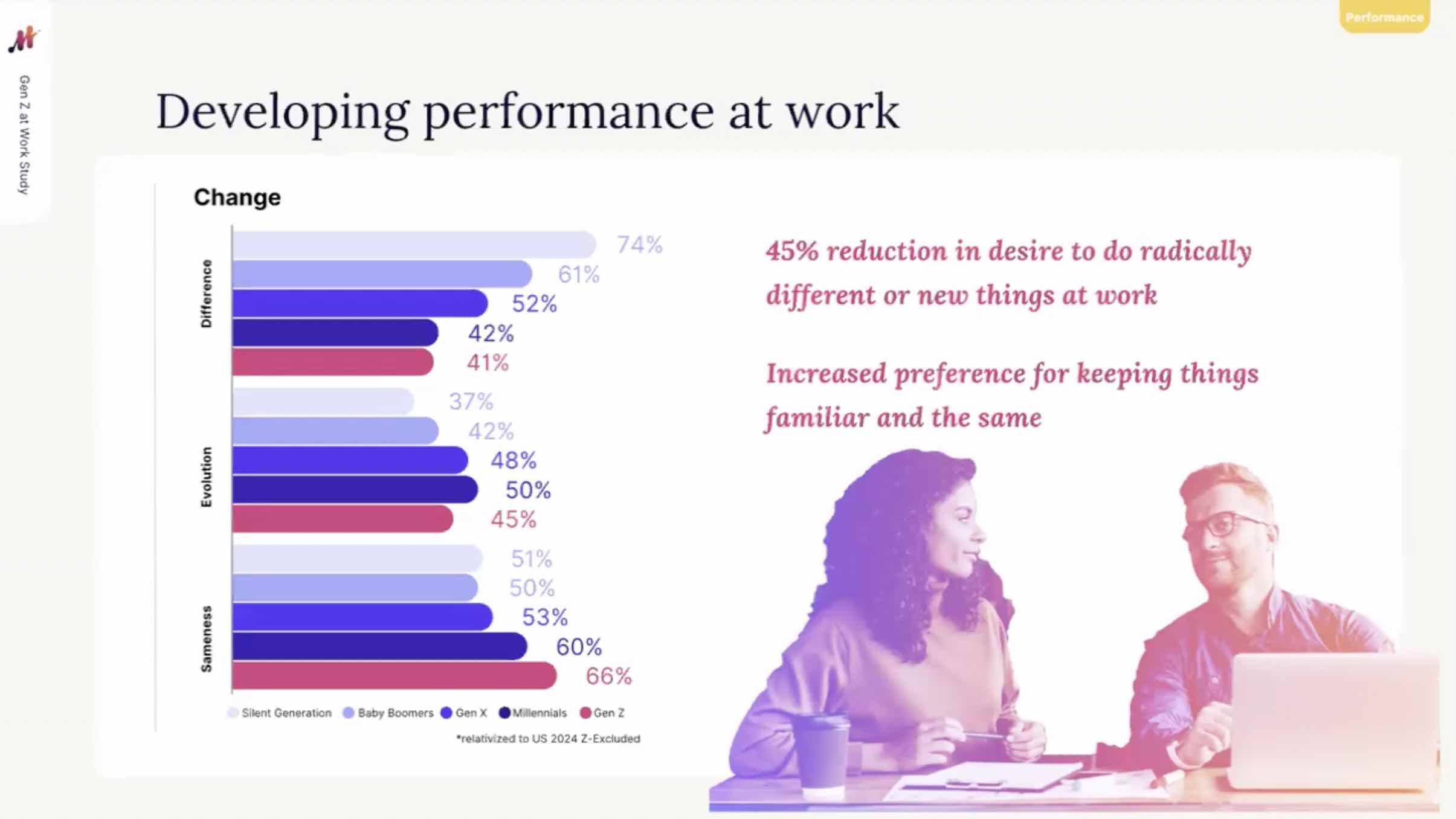
Now in here, we're looking at change, and we're looking at it through multiple lenses. The first one is around “How motivated am I to work in an environment where I'm doing something revolutionary, where I have a blank canvas, and I can just do something new?” Now someone who enjoys Differences enjoys being in roles for very short periods of time, they enjoy variety and change, and they cope and thrive with a constantly changing environment.
Think about roles, which are like three months in duration, so project work. People who are high on Difference like to have radical change within 18 months to three years, and so you would see them changing their roles every 18 months to three years, and if someone's extremely high, and you can individually measure how high you are or your teams are and all of these things, can be as fast as three months.
So that's someone who loves project work. The next one here doesn't like radical change. It prefers to have incremental change and it's focused on evolutionary steps, so evolving things and making them better and that their work changes incrementally. So the base of the work stays the same, and a nuanced part of it evolves and slightly changes, and we see in our data with the research we've done, is that that looks for changing the role every five to seven years.
And then finally we've got what we call Sameness and Sameness is all about being able to do something that's familiar without very much change at all. It's looking for things to keep similar and to keep the same, and this highlights a motivation for being with the one company in the one role for up to seven years without needing or seeking out something new and different, and so this here also helps us to look at burnout. We can predict how someone will reach their burnout.
So, if someone who is very high on Sameness will know that they can reach burnout if they're in a role where it's constantly changing, and that's what we see here in our data is that the younger generations have less desire to do radical new things and different things at work. They find constant change more difficult and more stressful and so there's this desire to keep things more similar and to seek things out that are more similar.
So you often find younger generations being able to say to you that they, you know “This doesn't fit,” “This isn't how it should be,” and they're mapping things against some model of the world that they have of how it should be, like it was where they did it before or what they know it to be or what they learned it to be.
So we see this whole cohort less comfortable with change and development, and so this means that they want to change and grow but they want to do it incrementally rather than radically. They want things to stay more the same than they want them to be different. And so the way that we help this generation in terms of their personal and professional development or change management initiatives when we think about the significant technology changes and AI transformation that you're all grappling with and leading and working through, we know it's only going to accelerate in ‘25 and 2026.
So our younger generations are going to be onboarding or changing roles or in the roles that they're in, and as we know, they're going to be experiencing some of the most significant rapid advancements and changes at work. Now in part, they've got a familiarity because they're more familiar with digital tools than others, but;
If the workplace and the roles and the tasks at work radically change, they've got less resilience for that change. And so how we think about how we roll that out the other data earlier helps us to know it needs to be procedural and it needs to be incremental, the changes.
This is one of the groups of data that's really, really concerning. The other pieces fill into this, and this is where you're going to start to see what some researchers and where one of them is talking heavily about, which is the leadership deficit that's forthcoming.
We see significant changes, so this asks the question, “What style of leadership brings out the best in me?” And this also then speaks to, “What kind of leader if at all do I aspire to be as a leader?” And the measurements of the data that we're measuring here is a leader whose style and preference is around Achievement is that we must achieve, we must be competitive, we must be number one in market, or if I'm in a team, “I must be number one, and I lead through recognition.”
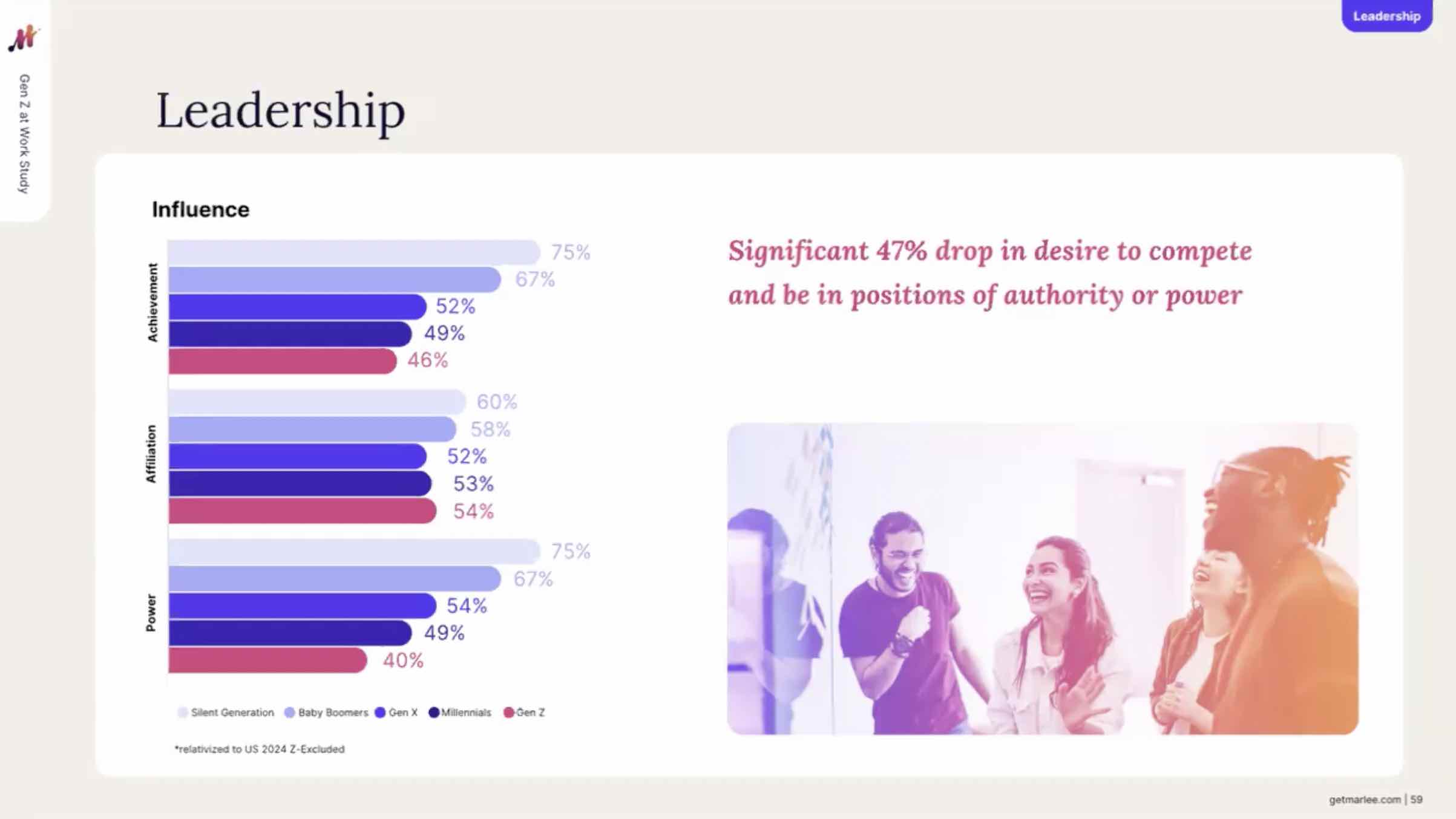
So I'm seeking recognition, and I want to recognize others in the workplace, and our style of leadership is competitive, Achievement orientated, being an example and a role model and then recognition for those who are the most competitive and who achieve the most. So this is an Achievement style of leadership, and then Affiliation is around being friends with the people you work with and being liked at work. So an affiliative style of leadership is about being personal at work, not just being at work. It's about friendship, it's about bringing your whole self to work, it's not about separation of I'm the leader, and you're not, it's about relational leadership.
And then the final one here is what we call the most traditional in American leadership style, which is Power and authority, and it's about hierarchical leadership, it is about title, and it's about the authority, and it's about decision-making being made by authoritative leadership. And so the person with the greatest title is the one authorized to be able to make the decisions.
And what we can see in the data is that the earlier generations this was the aspirational style of leadership that the earlier generations were seeking and many today still seek and how leadership is considered and defined in the workplace today. And so what we see in here is that there is a significant drop in the comfort or the desire for the younger generations to seek towards a title of authority and to wear the mantle of that sort of decision-making authority and far less competitive. So between power and achievement as a leadership style, it's competitive leadership, we must compete, we must be number one, we must have the biggest title, we must earn the most money, we must achieve the most.
This is not what this generation is seeking in terms of leadership, they're moving away from being in positions and titles that require one to lead, they don't want to be in those positions in the same way, it's not what they're scoping out. And really importantly, to note it's not the style of leader that motivates them. In achievement and power style, we get respect given to us by the achievements or the title.
For the younger generations what they are looking for is they need to feel like they're valued and that they trust you, and they feel a personal connection. So that means talking about personal things, cultivating a personal relationship, connecting with things outside of work, and there being less of a difference between my work self and me.
And so you'll hear in the conversations there's no doubt you're already seeing at work is our younger generations want to talk about the whole of themselves at work, they're used to doing that in the mediums that they work in, there's less of a delineation.
And so they feel less trusting of the managers and structures at work that don't also do that. So this is creating a significant leadership deficit, and you'll see some of the other distinctions as I wrap it all together. So as we knit it together now and we talk about these strategies, these are some of the key things that pull this together for us in the HR professional space and you start to think about your unique roles, whether it be compensation, whether it be learning and development, whether it be talent acquisition, whatever your lens actually is.
👉 Compare your team's leadership skills with Marlee’s free assessment—pinpoint motivations for achievement, power, and affiliation, and develop any leadership gaps.
So the biggest thing that we see here is the need to think about, “How do we initially onboard our younger generations rapidly for them to be confident and vital and to be productive at work?”
We know that our remote first hybrid environments are making it exceptionally hard for the younger generations who completed school or college during the pandemic, and many of them have not been in an office and haven't got the tools that they need around them that our data I just presented tells us. So we need to instead of fluid environments, we need to have a very rigorous procedural step-by-step process for them to work through. This will provide them with more confidence.
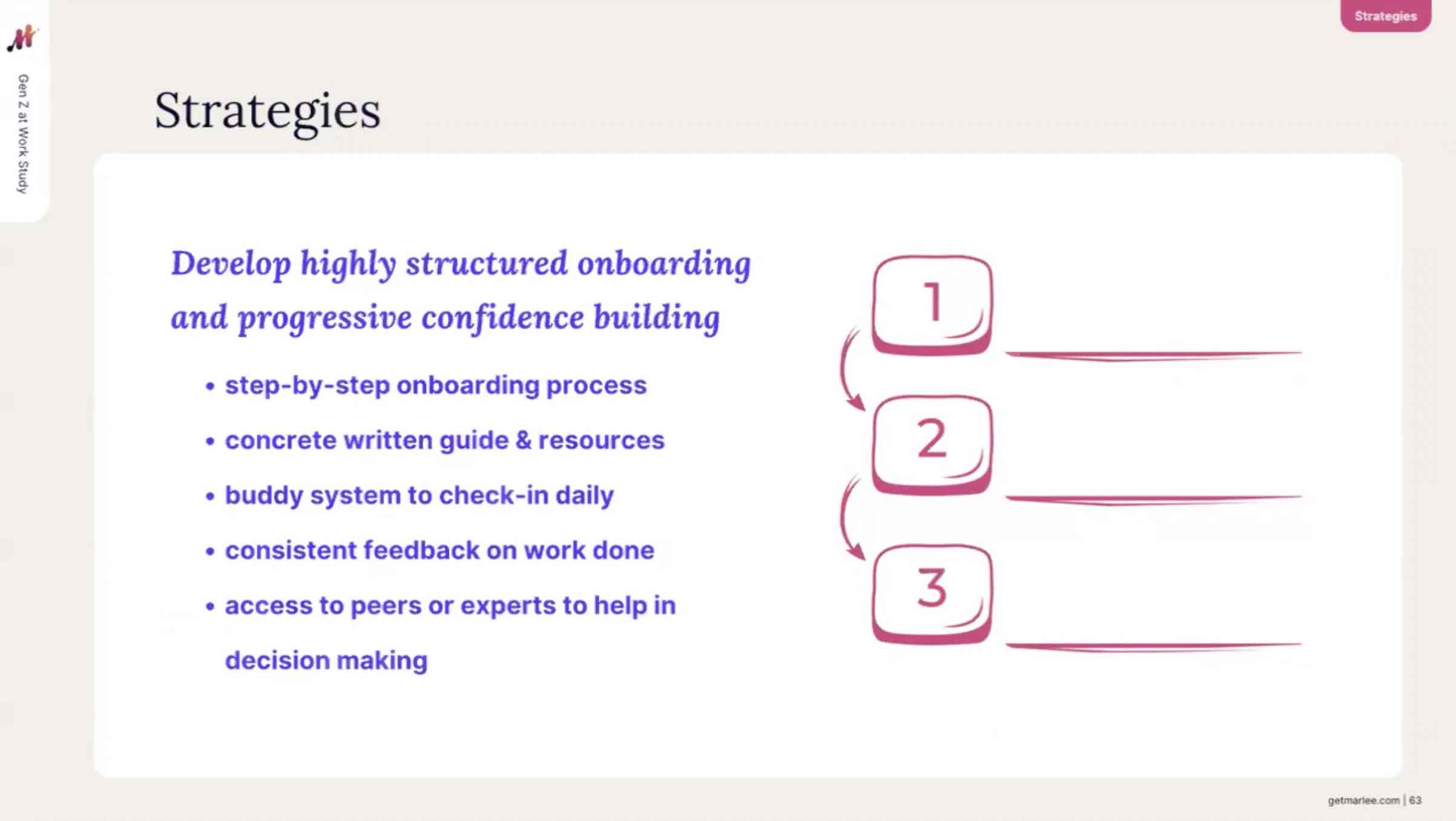
They need to have things written down and concrete, and so particularly in the early days of being in the first months of being in a role, if you verbally share instructions, a leader and a manager, they're unlikely to be retained because what we already know is that that generation has more anxiety in verbal environments.
So we need to follow it up in Slack, in Teams, in documents, manuals, and written forms, that helps people to know in digital forms and written digital forms what's next.
They need a buddy system. So most successful onboarding already has that in place, but we need to extend it much longer than Millennials or Gen Xers need to have it. It needs to be in the day of the role, not just in the onboarding. They need to have someone that they are engaging with and can chat back via text as needed, real-time, to be able to bounce things off, to validate their thinking and to get constant, constant input from. And that's what we call feedback.
So they need a leader, a manager, a mentor or a coach that they can get feedback to know that they're on track, that the work that they're doing is right for the role and right for the organization and then we need to be able to see that they can go, they need to know who in the organization or the team that they can go to for expert opinion, and what tools is appropriate in the organization to externally use and what access do they have those tools.
Depending on your organization, as we know, some websites are looped off. We know these younger generations value Reddit, LinkedIn and other places where they can go and find the sentiment in the world on different topics. And so letting them know what is useful and what they're allowed to use in those tools is exceptionally important for this onboarding into the organization and then the onboarding and sustainability once inside that role.
The next part is preparing for this forthcoming leadership deficit.
We've got this year, next year, and we can see that the older Gen Z are already in roles of leadership and will start forthcoming dramatically into those roles of leadership.
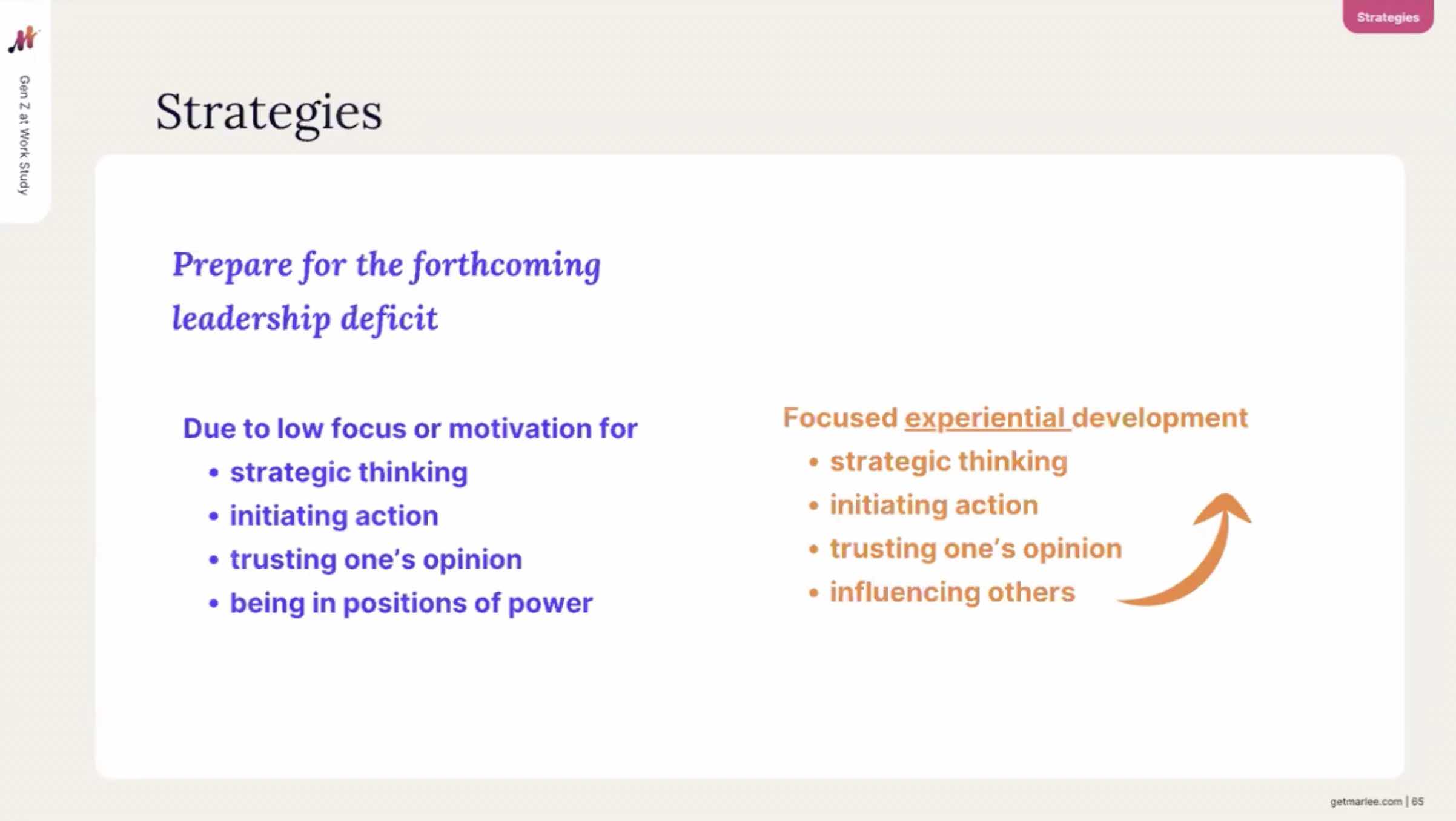
So in 2025 and 2026, the number one thing as we are thinking about the HR scope of work is to be able to get on the board across the leadership of your organization is how we're going to rapidly complete the process that the younger generations used to go through at university, which develops what is needed for them to;
- One, desire and to shape the new world of leadership, but;
- Two, that they've got the cognitive biases and the traits that we've just measured, which you can all measure in yourselves as well, that they can develop those rapidly.
All of this data, that we've presented to you is movable, is flexible. It's not personality. It's not something that's fixed. It has the capacity to shift, and to evolve with the right environment to facilitate and to foster it. And I think this is probably the most important part of the roles that we will all play together in the next decade, and it needs to start this year.
And so, as we've already seen, strategic thinking, which is that big-picture thinking, is dramatically reducing. The leadership trait of comfort to initiate, start things, drive things forward, and to take the first step is reduced. Having a point of view, and trusting oneself, and ease with having an opinion and a point of view and making decisions, which is a crucial part of leadership as it has been in the past, is decreased.
And now the younger generations are not wanting to take those responsibilities. They're not motivated for them. So these are on the decline and so this means that we need to build in the systems and the processes as we've already decided in the onboarding so that people get confident dropping in the deep end. Our customers have experimented with that, and I'm sure you have as well. It's not often successful.
So onboarding needs to be more structured, procedural, hand-holding. But in order for the future of work to thrive and to engage with the forthcoming collaboration between AI and people at work, the augmentation, we really need to help our younger generations get more comfort with. And you need to be supporting them with a workplace that facilitates critical thinking, strategic thinking, helping them to feel more comfortable to have divergent ideas in the room, that having different points of view is safe, that staying familiar is not the path forward, and that they can start to learn to hear their voices.
And so we need programs, we need Gen Xers and Millennial leaders to start fostering that, make it safe to experiment and to incrementally, bit by bit rather than radical programs, to help them to witness their voices, have a point of view, have a careful but supportive debate, to be able to bring those languages and styles of working back into the workforce for them and for them to feel okay and for them to be motivated by it. And it's absolutely possible to do this if we start this now. Now, in earlier generations, this happened at university.
And as many of you are well aware, university has radically changed since 2015 and 2016. So in the last decade, university has changed, and our younger students aren't having that kind of discourse that would normally happen at college and the university process. So organizations have to accept, we need to take that on board and we do it now in the workplace and build programs for that.
And so that brings us to change management, that as we bring these initiatives in, we need to identify that we've talked today about cohorts of generations.
No one is the same. You'll have in your generation an overarching generational bias, but each person is an individual. And in there, there are people who are leaders, there are people who are comfortable to initiate and to speak up. So we need to find them, we need to foster them, and we need them to be the role models to the rest of the generation. And we need to invest in them.
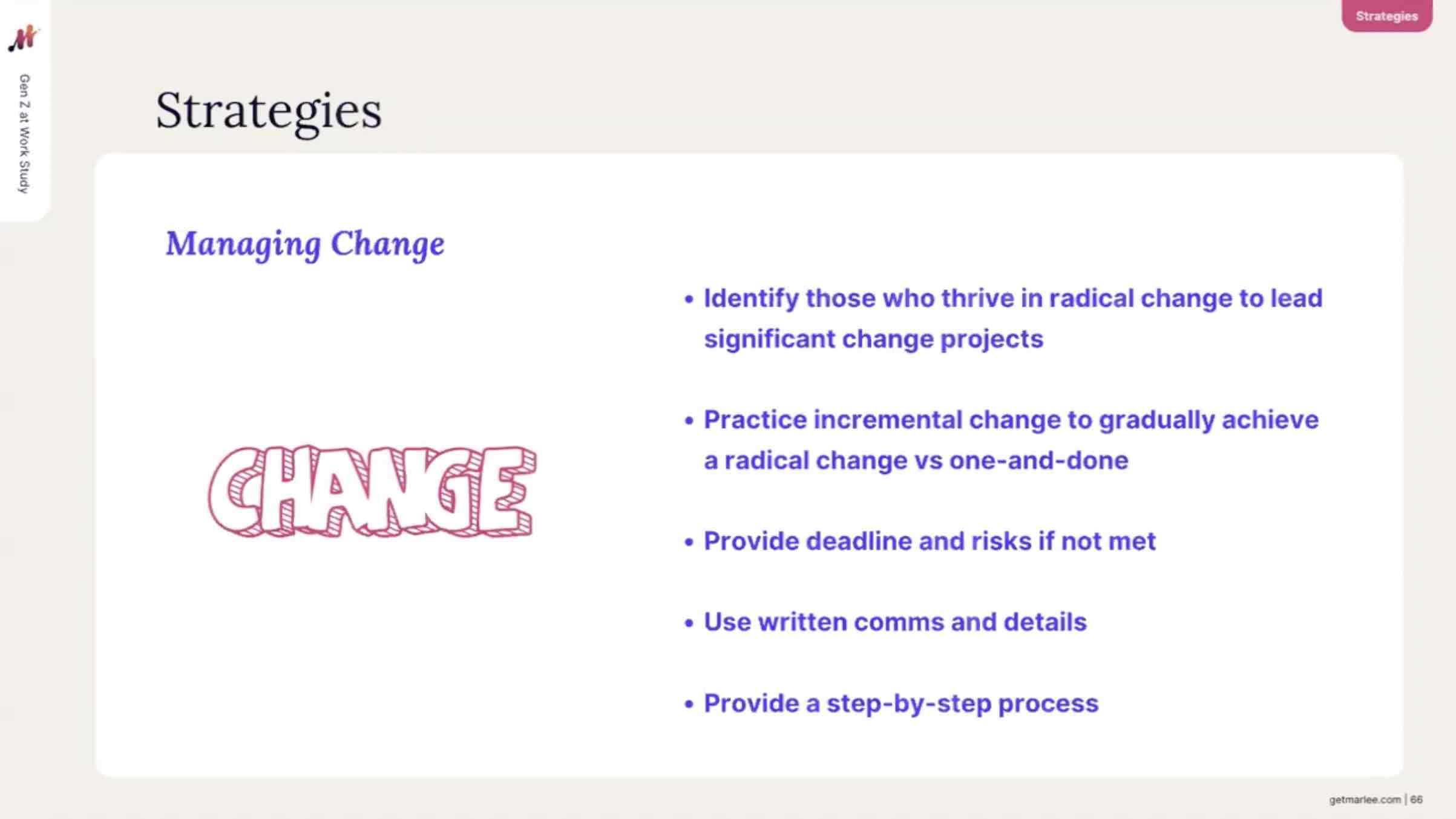
So they become the high potentials, they become the emerging leaders, and then they can help to be the voices that shape. The next one is to create radical change. So whether that be around incremental technological change versus a radical one-and-done. We need to provide deadlines and the risks, given that these generations need a deadline. We need to, in any change process, make sure those are communicated and clear. We need to use the unwritten, the written rule of comms.
Don't rely on verbal. If you're wondering why you have a great meeting and some of the younger generation don't implement following it, it's because the verbal environment is less familiar, they're less confident, and could be anxious.
And so we need to write it down. And then we need to give, for any change, step one, step two, step three, much more than we've ever had to before.
And the final one, wrapping it all together in terms of strategies, is around company communications.
So we need to make sure that we give a vision, but we also include the risks if we don't achieve these things. We need to, yes, still give the big picture, but we need to be way more concrete, more specific, more literal, because that gives more clarity to the younger generations. We need to follow up any in-person meetings or presentations with written comms, could be in Slack or Teams, but something written, and where possible to focus on that incremental change so that we don't burn out the younger generation with too much radical change. We won't bring out the best in them.
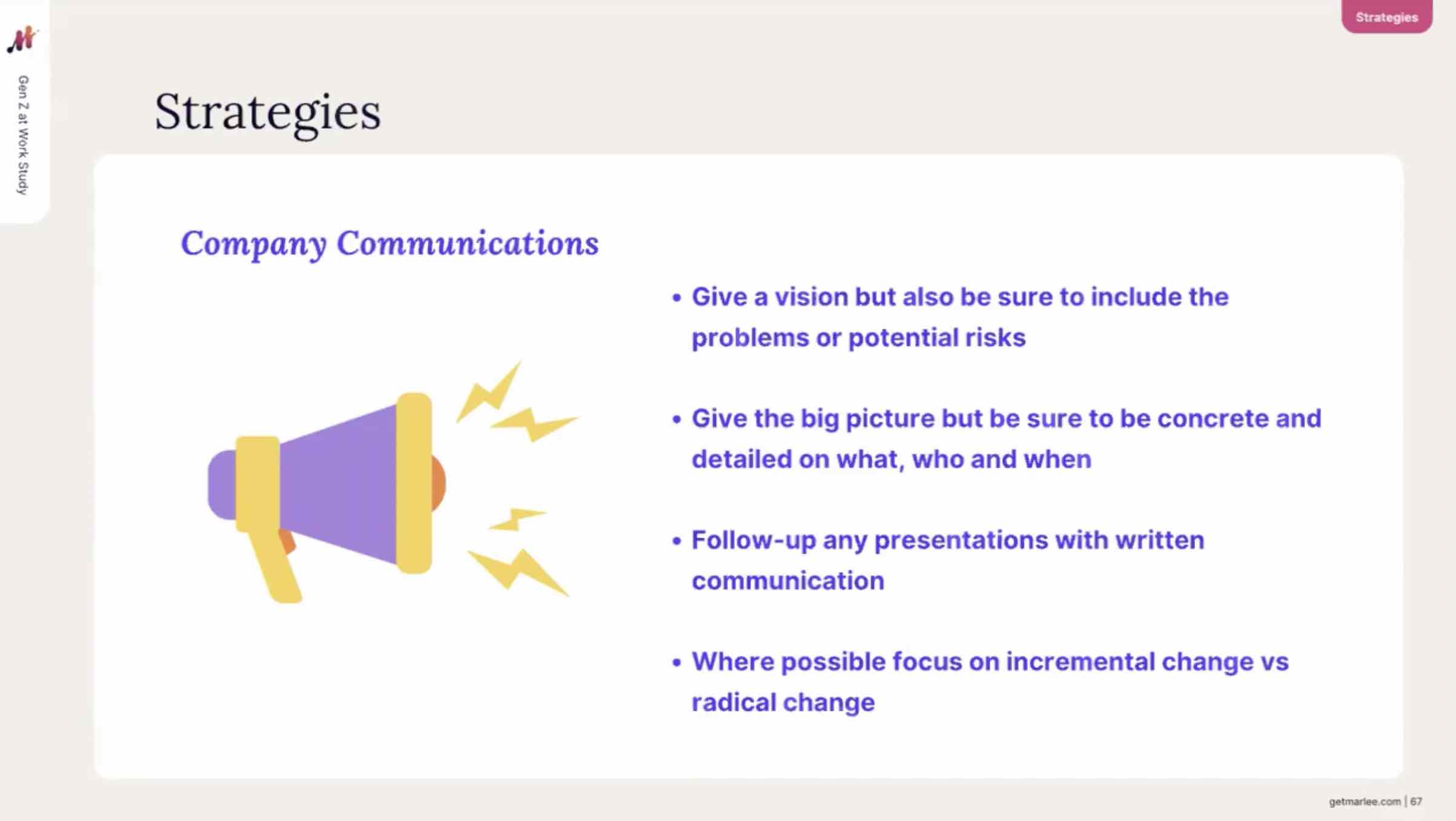
They're not going to be motivated by that. So these are the key things to start to think about in terms of those company communications. So we're going to pause here, and I'm going to turn it over to Jack to help me identify what's in the chat, what questions do we have. And if you haven't already asked a question, we'd really love to hear from you. What can we answer today? What insights do you need, or any comments you want to make from the research findings that we've shared so far?
Q&A
So Jack, over to you. What's the first question for us to answer?
Hello, Michelle. So we have a question from Fernando about:
“Where can people get the material to learn more about the motivations today, and also, how can we see the findings shared in this presentation?”
Great. So Jack is going to drop for you a link to the full Gen Z at Work research findings. So Jack will drop that in the chat for you, and Jack will also drop in there the link to our website. The website allows you to go to Marlee, and all of this data is actually available in Marlee where you can sign up for a free account, and you're able to then look at yourself compared to the different generations.
We've got what we call data Boards where you can see yourself, your team, or even your organization compared to these research findings. So you can start in there, you can start as an individual for free, and then go from there.
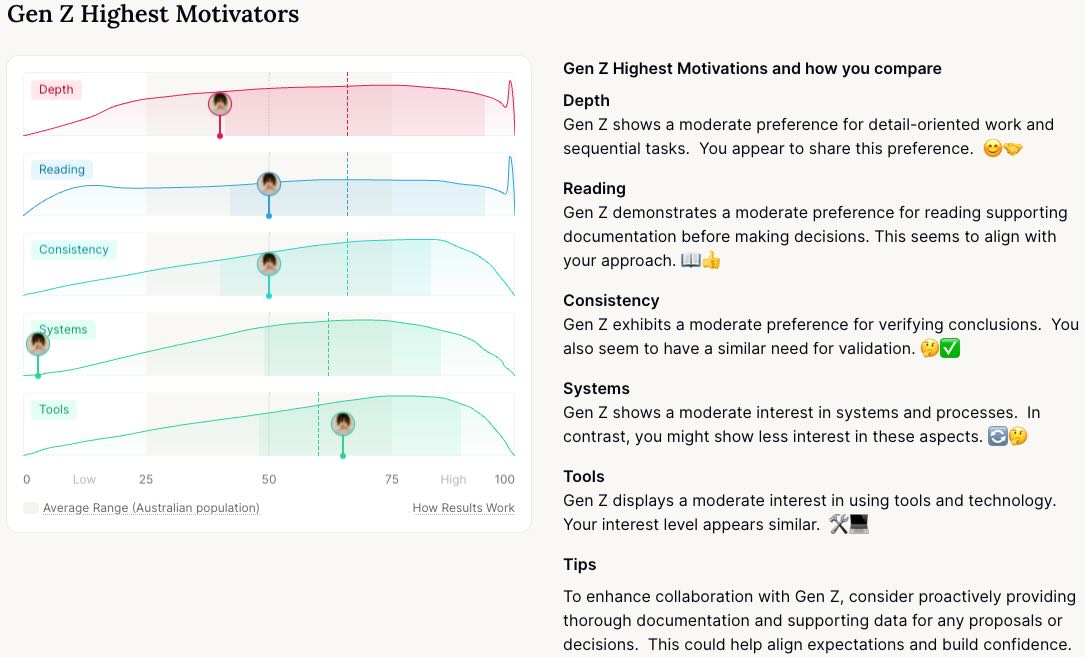
Gen Z and Me: A Marlee Board visualizing the highest motivators
Thanks, Jack. What was the next question?
So we had another question from Fernando asking about
“What the results conclude about Gen Z?”
This was asked in the context of Breadth and Depth, but I think we can speak about it from a context as well.
So overarchingly, Gen Z is a really empathetic, relational group of people, meaning that they want to belong at work, they value personal relationships at work, and that they value collaboration through externally referencing and seeking out the opinions of others.
It means that they are most confident in roles in places where they have clarity around what the expectations of them are, whether that be in literal concrete terms, or whether it be in the step-by-step terms. It means that Gen Z overall are not motivated by being in roles where they need to author and make decisions, or whether they need to initiate tasks and actions. So they're less comfortable in ambiguity, they're less comfortable in the overarching sense of the bigger picture.
And so they're a much more concrete, specific, literal generation, and they thrive and feel confident when they know what those expectations are of them, compared to other generations who thrive with creativity, Gen Xers, Millennials, thrive with newness, thrive with inventing things and figuring things out as they go. This generation is radically different. They thrive in different ways, and they will over time, with our support, be able to have more flexibility, have more adaptability.
But we know that this generation has suffered some of the challenges that, all at once from the pandemic, from the way university education has changed, and how they were onboard in digital native tools very young, and it has influenced the way that they think and the way that they move. And so it's possible to shift and to change these things and to have more flexibility, but a very different generation.
We have another question from Danielle, which is asking:
“How do you support leaders to build awareness to help younger generations build motivations for leadership?”
Yeah, I think the biggest one here is that the younger generations love to learn, we saw that in their data, they're really high on Use. So rather than theoretical concepts or theoretical models, it's about experiential learning. And so it's about incrementally, helping them to step incrementally into new experiences, and trying them on, and discovering the confidence from them. So it's putting them into simulations or experiences where they are set up to be most likely successful.
So incrementally, I kind of think about it from a coaching lens or change management lens as exposure therapy. If you're familiar with exposure therapy, it allows you to incrementally desensitize yourself to something that feels uncomfortable, and to build confidence incrementally. And I think the biggest way that we can support our younger generations building confidence for leadership is to first trust themselves, to first hear their internal voice, and to start to make small, okay if it fails decisions by trusting themselves, and incrementally increasing the risk factors that are involved with those until they're really energized and comfortable with big decisions, and authoring those first in their own life, then in their role, and then in leading other people.
The thing we have with this generation is we're going to have some of the most inclusive, compassionate, thoughtful leaders in the future. And I think that's the most exciting thing about this generation.
So Jack, thank you for those questions.
And thank you everybody for joining today and being so engaged and engaging with the data. You're welcome to jump in, jump into our site and immerse yourself in that data and other data that we have on performance and bringing out the X Factors in your team.
Want to see what drives your team?
Visit Marlee.com to create a Team Distribution Board and discover your team's unique motivation patterns—the key to unlocking strengths, bridging gaps, and bringing out their best.
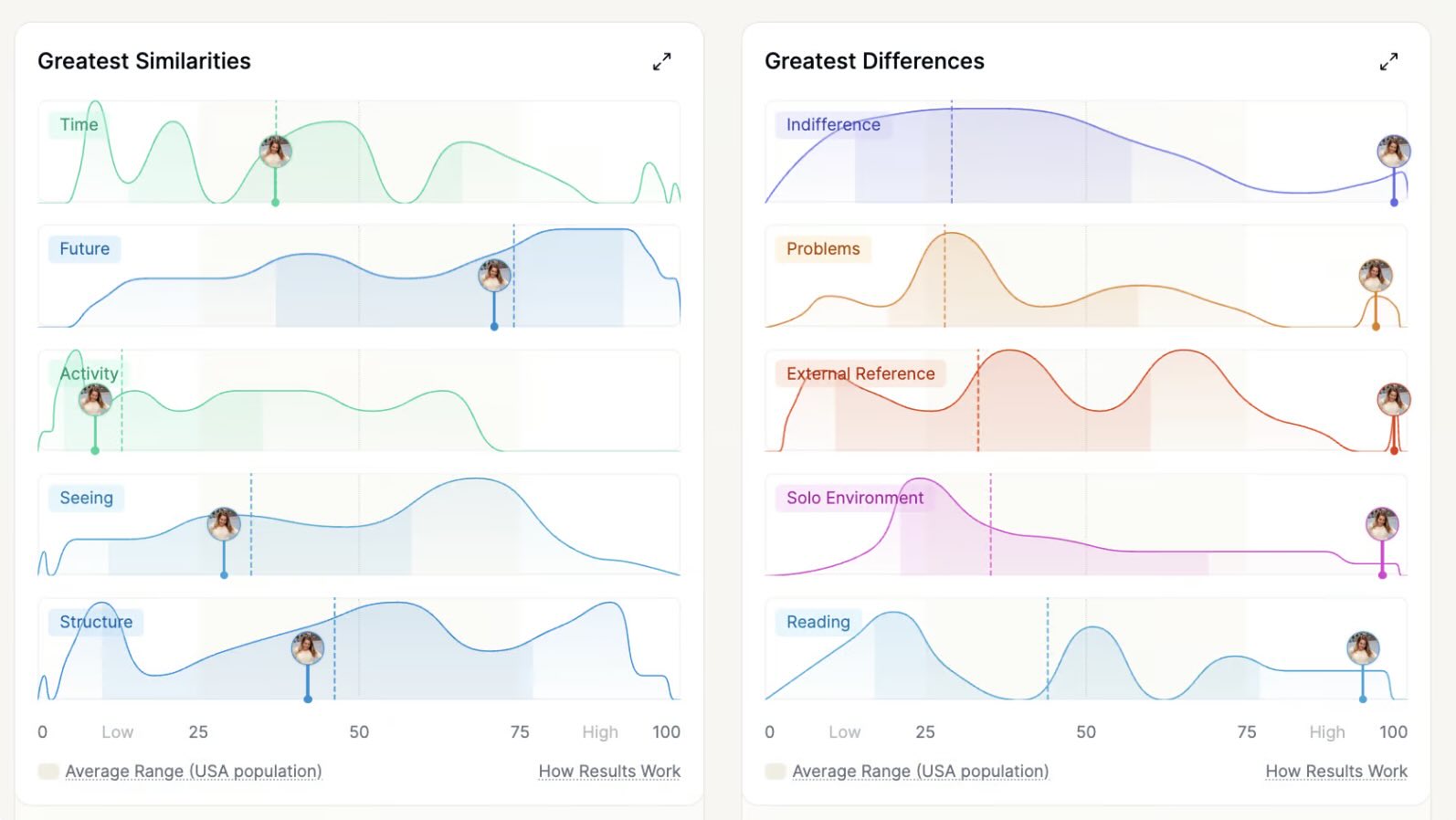
A Team Distribution Board in Marlee: See your team’s biggest motivator similarities and differences at a glance
See how you compare—start for free with Marlee today.
References
Marlee, (2024), Unlocking Gen Z at Work: A Generational Impact Study 2024, Available at: https://getmarlee.com/research-study/unlocking-gen-z-study

